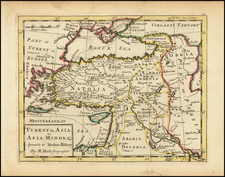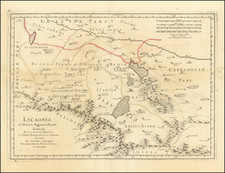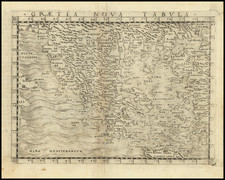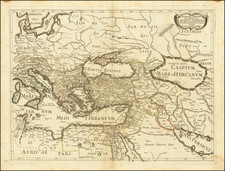Fanciful view of Nicaea (within the city of Iznik), from the Liber Chronicum (Nuremberg Chronicle), a landmark work of the 15th Century.
The Liber Chronicarum, or Nuremberg Chronicle, is a universal history, with a strong emphasis on geography, also known as a cosmography. The work was published by Anton Koberger on a commission from the merchants Sebald Schreyer and Sebastian Kammermeister. At this time Koberger, the second printer to set up shop in Nuremberg, was at the height of his business, with as many as eighteen presses at work.
For the compilation of the Latin text, which was translated into the vernacular by George Alt, Schedel called on Medieval and Renaissance writers including Bede, Vincent of Beauvais, Martin of Tropau, Flavio Biondo, Bartolomeo Platina, Aeneas Piccolomini, and Jacobus Philippus Foresti de Bergamo. Schedel split the book into parts: Creation, the ages of Adam, Noah, Abraham, and David, the Babylonian Captivity, the life of Christ, the Antichrist, and Judgement Day, followed by a text on Poland, on Europe, and all with a final note on how the book was made. The work contains 1,804 woodcut images executed from 641-3 woodblocks by Michael Wohlgemut (1434-1519) and his stepson Wilhelm Pleydenwurff (1460-1494). Interestingly, Albrecht Durer had worked and learned in the Wohlgemut shop in the late 1480s and Koberger was his godfather.
The Chronicle appeared in 1493, with the first print run taking place between March 16, 1492 and June 12, 1493, for the Latin edition, and to December 23, 1493, for the German translation. A reduced-size (quarto) version of the book, with new illustrations, was published in several editions by Johann Schonsperger, in Augsburg, between 1496 and 1500.
The encyclopedic book includes many portraits and illustrated scenes, including the famous Dance of Death. The geographic content of the Chronicle is also notable. In addition to the double-page Ptolemaic world map and a map of Northern Europe, there are large format views of many cities including Rome, Venice, Paris, Vienna, Florence, Genoa, Salzburg, Krakow, Breslau, Budapest, Prague, Jerusalem, Alexandria, Constantinople, as well as a number of towns in what would become the German Empire.
Hartmann Schedel (1440-1514) was a physician, book collector, and writer whose most famous work, the Liber Chronicarum (Nuremberg Chronicle), included some of the first printed views of many cities in Europe and across the world.
Schedel was born and died in Nuremberg, but he also traveled for his education. From 1456 to 1463 he lived in Leipzig, where he attended the University of Leipzig and earned his MA. From there he went to Padua, where he earned a Doctor of Medicine in 1466. After university, he worked for a time in Nördlingen and then returned to Nuremberg. In 1482 he was elected a member of the Great Council of Nuremberg.
The Chronicle was published in 1493. Besides this major work, one of Schedel’s most enduring legacies is his magnificent manuscript and printed book collection, one of the largest of the fifteenth century. In 1552, Schedel's grandson, Melchior Schedel, sold about 370 manuscripts and 600 printed works from Hartmann Schedel's library to Johann Jakob Fugger. Fugger later sold his library to Duke Albert V of Bavaria in 1571. This library is now mostly preserved in the Bayerische Staasbibliothek in Munich.
Among the surviving portions of Schedel's library are the records for the publication of the Chronicle, including Schedel's contract with Anton Koberger for the publication of the work and the financing of the work by Sebald Schreyer and Sebastian Kammermeister, as well as the contracts with Wohlgemut and Pleydenwurff for the original artworks and engravings. The collection also includes original manuscript copies of the work in Latin and German.













![[ Turkey / Asia Minor ] Tabula Asiae I (](https://storage.googleapis.com/raremaps/img/small/103875.jpg)
![[ Asia Minor ] Tabu. Nova Asiae Mi.](https://storage.googleapis.com/raremaps/img/small/103196.jpg)